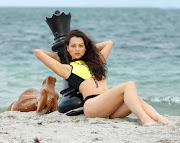While in Corpus Christi, visited the U.S.S. Lexington! First time I've ever been on a ship longer than about 35'. The Lexington's Flight Deck is 910' long, and 196' at its widest point. (1, 2.
I couldn't help thinking the flight deck - 303 yards x 65 yards at its widest point - would make a nice par 4 of about 290 yards. One would tee an iron from the stern, land in the fattish 50+ yard width beside the conning tower, then bore a knocked down wedge through the wind, and into a green surrounded by water on three sides. I would place the pin about 25' from the back edge. If you put the pin near a corner, only rookies would go for it with a wedge approach. If you elevated the green, and built a St. Andrews' 18th type "Valley of Sin" in front, you'd have a darned challenging hole. Especially if the ocean breeze was blowing into the face of your approach. I believe, seriously, most pros would intentionally land short of the pin, so as not to take any risk of going long. Because the flight deck narrows radically near the bow, I doubt anyone would go for the green from the tee - unless they were trailing by one, and this was the last hole, and the wind was absolutely still. Also, as was the case during my visit, I would place some fighter planes around the flight deck as additional obstacles/decorations. This would be especially good during a tournament, as you could move the planes around from day to day, in conjunction with the pin placement for that day, and also in conjunction with the tee box placement - which could be moved from port to starboard along the stern. I would definitely have the tee shot come out through a tunnel of fighter planes on some days. That would be quite majestic. Imagine a clubhouse and bleachers facing out from an ocean cliff. The golfers could walk down a bridge to play the 18 hole on the aircraft carrier, with fans watching from above. After, golfers could repair to the casinos below decks, and then to their staterooms.
This is the fifth Lexington - so named in 1943 - after the fourth Lexington was sunk in the Battle of the Coral Sea. This fifth Lexington was repeatedly hit by the Japanese during WWII - including a major wounding from a kamikaze plane - yet fought on. Japanese radio reported this Lexington as sunk on four separate occasions, and finally nicknamed her "The Blue Ghost", in honor of her distinctive metallic blue paint, and her seeming resurrection again and again. The metallic blue coloring is very similar to the Dallas Cowboys' football pants' color from the 1970's.
After the aforementioned kamikaze attack, the Lexington lost steering, and circled around the Pacific Ocean both out of control and burning. The Captain broadcast for the crew to go about its duties calmly, and to not worry. The Captain said worrying was his job, and he would do the worrying for all of them. The Lexington eventually guided herself back to Pearl Harbor by steering with her engines: firing on the port side, then the starboard side, to control her direction.
I didn't realize an aircraft carrier rarely, if ever, travelled alone. Aircraft carriers were so valuable that they often went out in the center of armadas, and would be surrounded by circular layers of progressively smaller ships, which formed defensive perimeters to protect aircraft carriers against submarine attack. A sub wanting to get a shot would first have to play like Frogger in the video game, and try to work through the lanes of smaller ships, in order to get to the larger target.
I really dug kicking around below decks, and seeing what an aircraft carrier is all about. I saw this pilot briefing room, complete with comfy chairs for the pilots, who must've been quite pampered, considering it was wartime. Flight was still so romantic during WWII. The military must've wanted the pilots as sharp and as rested as possible for their flights. No tired butts for those boys - only cushy leather chairs would do.
I saw one sign saying the ship carried 1550 crew, and another sign saying the ship carried 3,748 crew, so I don't know the correct figure. The Lexington had barber shop chairs, dental chairs(performed 6,000 dental procedures per year), infirmary, operating rooms(specially designed for quick clean-up during high volume periods), chapel, and a small theater. It had an airplane repair area in midship. And guns everywhere: 12 five-inch guns + 68 40mm guns. It's hard to see how any plane could've gotten through the guns - except in a massive simultaneous attack of numerous planes - which did happen a few times.
As fun, and as interesting, and as big as the Lexington is, I have to admit: I would've felt a bit constricted if I were confined to her on a voyage. I'm a wide open spaces on land guy. On a voyage, once you get the lay of the ship, well, that's all there is. It's a lot: 290 yards x 60 yards x 16 decks high(5 deck Conning Tower + 11 decks below the Flight Deck) - but that is all there is. Once on the ocean, a sailor was stuck. He couldn't go anywhere, except to stroll around the ship. And around, and around, and up and down, and up and down. Sounds odd, but I would've gotten a bit claustrophobic. I think I would've hung around the flight deck in my spare time, just to see some horizon.
All in all, though, an aircraft carrier is mega-cool. U.S.S. Lexington history: 1, 2
Addendum:
Several U.S. cities have turned down memorials to war related heroes or ships, for politically correct reasons of not wanting to promote war. That is a shame - for those cities, and for our nation. Wretchard comments.
Subscribe to:
Post Comments (Atom)








1 comment:
Post a Comment